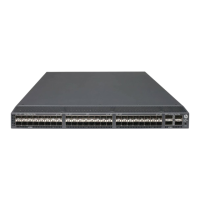64
Usage guidelines
You cannot edit a reaction entry after it is created. To change the attributes in a reaction entry, use
the undo reaction command to delete the entry, and then configure a new one.
Examples
# Create reaction entry 1 for monitoring packet loss in the UDP jitter operation. Before the NQA
operation starts, the initial state of the reaction entry is invalid. After the operation, the total number of
the lost packets is checked against the threshold. If the number reaches or exceeds 100, the state of
the reaction entry is set to over-threshold. Otherwise, the state is set to below-threshold. Once the
state of the reaction entry changes, a trap message is generated and sent to the NMS.
<Sysname> system-view
[Sysname] nqa entry admin test
[Sysname-nqa-admin-test] type udp-jitter
[Sysname-nqa-admin-test-udp-jitter] reaction 1 checked-element packet-loss
threshold-type accumulate 100 action-type trap-only
reaction checked-element probe-duration
Use reaction checked-element probe-duration to configure a reaction entry for monitoring the
probe duration.
Use undo reaction to delete a reaction entry.
Syntax
reaction item-number checked-element probe-duration threshold-type { accumulate
accumulate-occurrences | average | consecutive consecutive-occurrences } threshold-value
upper-threshold lower-threshold [ action-type { none | trap-only } ]
undo reaction item-number
Default
No reaction entries for monitoring the probe duration exist.
Views
ICMP echo/TCP/UDP echo operation view
DHCP/DLSw/DNS/FTP/HTTP/SNMP operation view
Predefined user roles
network-admin
Parameters
item-number: Assigns an ID to the reaction entry, in the range of 1 to 10.
threshold-type: Specifies a threshold type.
accumulate accumulate-occurrences: Checks the total number of threshold violations. The value
range is 1 to 15.
average: Checks the average probe duration.
consecutive consecutive-occurrences: Specifies the number of consecutive threshold violations
after the NQA operation starts. The value range is 1 to 16.
threshold-value: Specifies threshold range in milliseconds.
upper-threshold: Specifies the upper limit in the range of 0 to 3600000.
lower-threshold: Specifies the lower limit in the range of 0 to 3600000. It must not be greater than the
upper threshold.

